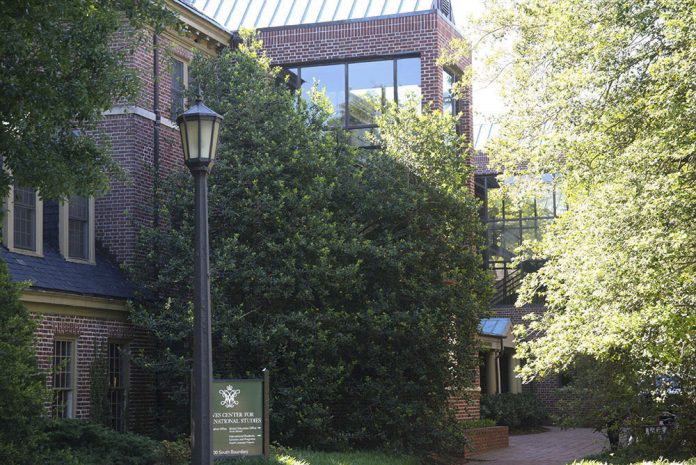Saturday, Nov. 21, the College of William and Mary welcomed professor of Japanese literature and cultural studies Christine Marran from the University of Minnesota to give a talk entitled “Biotropes: Interpreting the Non-Human World in Japanese Literature.” Marran was brought to campus in honor of the inauguration of the new Japanese studies major at the College, with funding for the event stemming from the Wendy and Emery Reves Center for International Studies, the Asian and Middle Eastern Studies Department and Environmental Science and Policy Department. Her presentation primarily focused on her 2017 book “Ecology Without Culture,” which she discussed at length.
In his introduction, professor of Japanese studies Michael Cronin commented on the new Japanese Studies major.
“Dr. Marran’s work is exactly a model of what we want to encourage in our major,” Cronin said. “To do the kind of work that explores Japan’s relevance — not its uniqueness, but its cultural and economic relevance to broader global concerns.”
“Dr. Marran’s work is exactly a model of what we want to encourage in our major,” Cronin said. “To do the kind of work that explores Japan’s relevance — not its uniqueness, but its cultural and economic relevance to broader global concerns.”
To elaborate on those themes, Marran spoke about the intersection of Japanese literature, literary criticism, ecology and environmental disasters.
Marran’s work focuses on the 1956 Minamata disaster, when organic mercury spilled into the Minamata Bay in Japan, causing illness in humans and animals alike. In response, Japanese writer Michiko Ichimure wrote her book, “Paradise in a Sea of Sorrows.”
“The power of the novel was that it wove together a fabric of different languages that creates a universalism,” Marran said. “People came in the hundreds.”
“The power of the novel was that it wove together a fabric of different languages that creates a universalism,” Marran said. “People came in the hundreds.”
This incident prompted political changes and scientific research on the concepts of biomagnification and bioaccumulation of toxins.
In describing the process of how literature can address environmental concerns, Marran highlighted the work of two literary critics who helped shape her thoughts about her tool of literary criticism, which she calls a “biotrope.” Timothy Morton and his book “Ecology without Nature” — which inspired Marran’s own book title — and Amitav Ghosh’s “The Great Derangement” argue that Western literature creates perceptions of nature that defy its agency and make it easier for readers to deny issues like climate change.
“There are certain concepts of nature, particularly those in British romantic literature, that make it hard for us from an ecocritical perspective to see or document or understand the environment,” Marran said. “While this can be true, it could be an argument that could be conceived as unwittingly Eurocentric.”
With concerns of Eurocentrism in their interpretations, she turned to explorations of early modern Japanese literature, where she discovered strains of the same phenomenon.
“Early modern Japanese literature colludes in disregarding planetary health,” Marran said.
She argued that “biotropes” as a construct allow ecocritical literary critics to examine both the actual history of the biological factor and the “trope,” or how it is being used as a tool for metaphor or allegory. This is her way of responding to descriptions of nature and the environment in Japanese literature.
French and Francophone studies professor Giulia Pacini, who researches trees in 18th century French literature, questioned Marran, suggesting that the idea of a “biotrope” asks us to read on multiple levels. Pacini wondered if it therefore contradicted Ghosh and Morton’s claims that classic literature should be read monolithically.
“Ghosh’s claim in ‘The Great Derangement’ is problematic because there, too, he’s reading a literary tradition monolithically without opening up alternative possibilities for reading, I would argue,” Pacini said. “The ‘biotrope’ might be precisely what allows you to do that alternative reading.”
The discussion between the two women illustrated the interdisciplinary back and forth of Marran’s topic, as history, literature and ecology collided across national boundaries and produced knowledge.
Geleila Yonas ‘23 appreciated the interdisciplinary nature of the talk.
“I think the holistic aspect of this talk and of all of our liberal arts education opens up our worldview,” Yonas said. “We aren’t seeing any piece of literature one certain way, and we can see how it all connects. I love the international aspect of it. We are going past the American bias, which I really find valuable in this day and age. We have to open up our mindsets.”
“I think the holistic aspect of this talk and of all of our liberal arts education opens up our worldview,” Yonas said. “We aren’t seeing any piece of literature one certain way, and we can see how it all connects. I love the international aspect of it. We are going past the American bias, which I really find valuable in this day and age. We have to open up our mindsets.”
Yonas also said that literature addressing environmental issues was necessary in contemporary interdisciplinary conversations.
“With the growing climate change discussion now, I think connecting with ecology and the environment is at the forefront of our minds,” Yonas said.

